ASMAR

ASMAR or Astilleros y Maestranzas de la Armada is a Chilean state-owned shipyard service dealing both with military and civilian vessels.
- Cirujano Videla (1964)
- Fuentealba (1966)
- Odger (1966)
- Castor (1968)
- Papudo (1970)
- Maipo (1981)
In order to support amphibious operations during the landing in Pisagua by carrying significant quantities of cargo, and landing troops directly onto an unimproved shore, the Government built flat-bottomed landing craft, called Chalanas. They transported 1,200 men in the first landing and took onboard 600 men in less than 2 hours for the second landing. [1] [ self-published source? ]: 40

ASMAR or Astilleros y Maestranzas de la Armada is a Chilean state-owned shipyard service dealing both with military and civilian vessels.

Located in Caleta de la Barca, (today Caleta Abarca), this shipyard registers works:

Located in Valdivia, Chile
1845 in Valparaíso [2]
Located in Valparíso
MARCO is a company founded in Iquique, dedicated to construction, repair, and rebuild of steel vessels of up to 95M Length overall. The shipyard also offers consulting and engineering work services.
Located in Valdivia

The Argentine Navy is the navy of Argentina. It is one of the three branches of the Armed Forces of the Argentine Republic, together with the Army and the Air Force.

The Chilean Navy is the naval warfare service branch of the Chilean Armed Forces. It is under the Ministry of National Defense. Its headquarters are at Edificio Armada de Chile, Valparaiso.
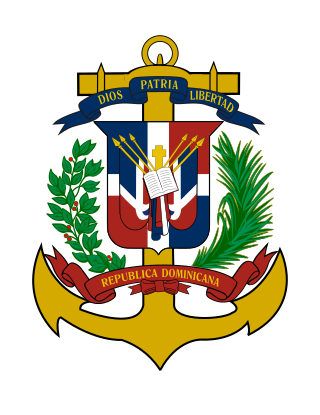
The Navy of the Dominican Republic, is one of the three branches of the Armed Forces of the Dominican Republic, together with the Army and the Air Force.

The Sa'ar 4 or Reshef class were a series of fast attack craft built based on Israeli Navy designs grounded in accumulated experience derived in the operation of "Cherbourg" classes. Thirteen were built at the Israel Shipyards, ten for the Israeli Navy and three for the South African Navy. Another six were built for the South African Navy in South Africa with Israeli assistance.

In late 19th-century naval terminology, torpedo gunboats were a form of gunboat armed with torpedoes and designed for hunting and destroying smaller torpedo boats. By the end of the 1890s torpedo gunboats were superseded by their more successful contemporaries, the torpedo boat destroyers.

Corral is a town, commune and sea port in Valdivia Province, Los Ríos Region, Chile. It is located south of Corral Bay. Corral is best known for the forts of Corral Bay, a system of defensive batteries and forts made to protect Valdivia during colonial times. Corral was the headquarters of the system. Economic activities in Corral revolve around forestry, aquaculture, fishing, port services and both heritage and eco tourism.
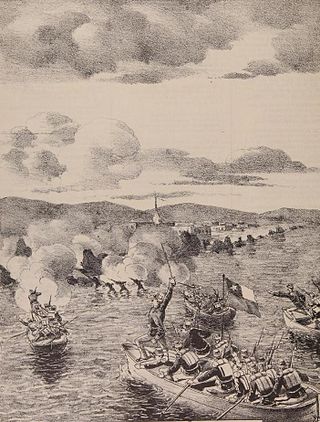
The Battle of Pisagua, was a landing operation of the War of the Pacific, fought on November 2, 1879, between Chile and the combined forces of Bolivia and Peru. The Chilean army commanded by Erasmo Escala, supported by the Chilean Fleet, launched an amphibious assault on the port of Pisagua and successfully drove the defending Bolivian-Peruvian forces, led by Gen. Juan Buendia, back from the shore. They established a beachhead that allowed an initial force of about 1,000 Chilean soldiers in two assault waves to disembark onto Peruvian territory at Pisagua in Tarapacá Department. This region was the principal territory in dispute.

USS San Bernardino (LST-1189) was the eleventh of twenty Newport-class tank landing ships of the United States Navy (USN) which replaced the traditional bow door-design tank landing ships (LSTs). The second USN ship to be named after the city in California, the ship was constructed by National Steel and Shipbuilding Company of San Diego, California. The LST was launched in 1970 and was commissioned in 1971. San Bernardino participated in the Vietnam War, earning one battle star and took part in operations in the Middle East. The ship was decommissioned 1995 and transferred to the Chilean Navy. In Chilean service, the vessel was renamed Valdivia (LST-93) for a battle during the Chilean War of Independence. The LST was recommissioned that year and during its service, took part in humanitarian efforts following earthquakes in Chile in 2010. In 2011 the Chilean Navy took Valdivia out of service due to repairs to the ship no longer being economical.

The Chilean Marine Corps is an entity of the Chilean Navy special forces which specializes in amphibious assaults.

The OPV-80 class is a class of offshore patrol vessels that are currently operated by the Chilean Navy and Colombian National Navy. The Argentine Navy have also expressed an interest in building these ships.
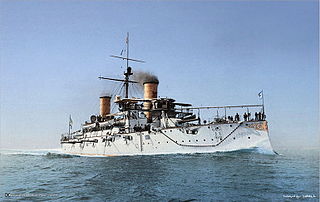
ARA General Belgrano was a Giuseppe Garibaldi-class armoured cruiser of the Argentine Navy. The ship was built in Italy, along with three sister ships also for Argentina. The vessel was the first to have been named after the Argentine founding father Manuel Belgrano (1770–1820). The ship was laid down in 1896 and served on the Argentine Navy until she was stricken on 8 May 1947.
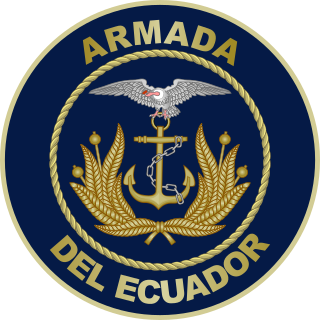
The Ecuadorian Navy is an Ecuadorian entity responsible for the surveillance and protection of national maritime territory and has a personnel of 9,400 men to protect a coastline of 2,237 km which reaches far into the Pacific Ocean. The vessels are identified by a ship prefix of B.A.E.: Buque de la Armada del Ecuador or L.A.E.: Lancha de la Armada del Ecuador.

The corvette Abtao was a wooden ship built in Scotland during 1864 of 1.600 tons and 800 IHP. She fought in the War of the Pacific and was in service for the Chilean Navy until 1922.

The First Chilean Navy Squadron was the heterogeneous naval force that terminated Spanish colonial rule in the Pacific and protagonized the most important naval actions of in the Latin American wars of independence. The Chilean revolutionary government organized the squadron in order to carry the war to the Viceroyalty of Perú, then the center of Spanish power in South America, and thus secure the independence of Chile and Argentina.

The history of rail transport in Chile has gone through several periods of boom and bust. It began in 1840, with the construction by William Wheelwright of the first branch in the north. Further construction proceeded apace linking cities from Pisagua all the way to Puerto Montt.

The Astilleros y Maestranzas de la Armada(English: Shipyards and Maestranzas of the Navy), better known by the acronym ASMAR, is a Chilean state-owned shipbuilding company with autonomous administration, which provides services to the Chilean Navy, mainly, and also to other domestic and foreign customers. Its predecessor was Arsenales de Marina, created in 1895, until it was restructured and adopted its current name on April 6, 1960.
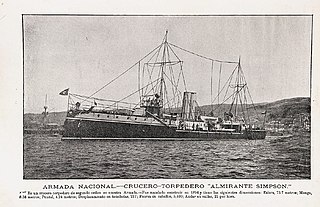
Almirante Simpson was a unique design of torpedo gunboat, built by the British shipyard Laird Brothers. Acquired by the Chilean Navy in 1895, during construction. The ship had a brief service in Chile, being transferred to the Ecuadorian Navy in 1907 and renamed Libertador Bolívar. She was the first Ecuadorian warship of the 20th century and had an important participation in the Ecuadorian Civil War of 1913–1916. After the war, the ship was retired and then sank in 1928.
Colo Colo was a Colo Colo-class torpedo boat built for the Chilean Navy in 1880. The torpedo boat participated in the War of the Pacific, where it fought in the blockade of Callao and patrolled Lake Titicaca in the final phase of that war.